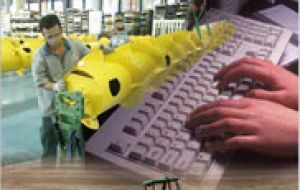MercoPress. South Atlantic News Agency
Brazil’s December industrial production brings hope after a dismal 0.3% for 2011
 Investment in infrastructure is vital for Brazilian development
Investment in infrastructure is vital for Brazilian development Rising output at Brazil's factories and mines in December, following a dismal 2011 performance, should help activity in 2012 as falling interest rates and rising investment help sustain growth in Latin America's largest economy
Industrial production advanced a seasonally adjusted 0.9% in December compared with November, the Brazilian Institute of Geography and Statistics, or IBGE, said Tuesday. The second-consecutive month of growth helped Brazil climb out to a 0.3% rise in industrial production for all of 2011, off sharply from a 10.5% advance in 2010.
December's performance underscored a burgeoning recovery in Brazil's industrial sector after a sharp deceleration in the second half of 2011, when production was undermined by a strong Brazilian currency that stoked imports of cheap manufactured goods.
But record-low unemployment, lower interest rates and government tax breaks should provide enough fuel to foster the flames of a recovery in 2012, economists said.
The Brazilian Central Bank, concerned about the potential fallout from Europe's debt crisis on economic activity, embarked on a rate-cutting cycle in August. The bank reduced its benchmark Selic interest rate at four consecutive meetings to 10.5%, with indications the rate could be headed for single digits in coming months.
Brazil's Finance Ministry also moved to promote domestic demand, unveiling a wide-reaching package of tax cuts and financing measures on December first.
The 11% drop in the Real against the dollar since the end of July has provided some relief for manufacturers hit by slowing demand and an increase in imports. Since the beginning of the year, the Real has rallied 7.4%.
Car and consumer goods manufacturers serving Brazil’s expanding middle class, who are spending the windfall provided by rising wages and record-low unemployment, fared better last year than import-sensitive industries.
Automotive production rose 2.4% last year, while production of textiles plunged 14.9% and electronics slipped 3.7% as the strong Real during the first half of the year fueled demand for Chinese imports.
Looking ahead, production of capital goods, a barometer of future investment, rose 3.7% in December. Consumer goods increased 1.5%.
The Brazilian economy contracted in the third quarter for the first time in more than two years, while business confidence in the fourth quarter fell to its lowest level since the start of 2009.
The government has cut taxes on personal loans, home appliances, food staples and foreigner purchases of stocks and corporate bonds tied to infrastructure projects in a bid to bolster demand. It also increased a tax on imported cars to protect local manufacturers from Chinese and South Korean competitors.
Best performing sectors were autos (up 2.4%), transport equipment (up 8%) and mining industries (up 2.1%) while those which fared poorly included textiles (down 14.9%), shoes and leather products (down 10.4%), machinery and electrical goods (down 3.7%) and chemicals (down 2.1%).
The National Confederation of Industry said the slower industrial growth was essentially due to the global economic crisis and the appreciation of the Real against the dollar.
“The effect of lower interest rates should increase activity during the year,” said Rafael Bacciotti, an economist at Sao Paulo-based consulting group Tendencias.
Bacciotti noted the 3.3% increase last year in production of capital goods--the heavy equipment companies need to expand--was an indicator that the outlook for investment in Brazil is bright despite a somewhat-gloomy global picture.
“The positive scenario should be maintained this year,” Bacciotti said, citing government auctions of airport and road concessions. Civil construction and transport also should see greater activity as Brazil beefs up infrastructure ahead of the 2014 World Soccer Cup and the 2016 Summer Olympics, the economist added.
Brazil needs to increase its investment rate if it hopes to reach the government's goal of 5% growth, said Alcides Leite, a professor of economics at Sao Paulo's Trevisan School of Business. Investments as a percentage of GDP need to climb to 25% from the current 19%, Leite said.
“The structural problem in Brazil is investment, not the crisis in Europe,” Leite said. Brazil is limited to growth of about 3% at current investment levels. Higher investment would lead to a “virtuous cycle” that better balances supply and demand, allowing interest rates to remain low and reducing the government's debt costs, Leite said. That would mean more cash in government coffers for investments.




Top Comments
Disclaimer & comment rulesCommenting for this story is now closed.
If you have a Facebook account, become a fan and comment on our Facebook Page!